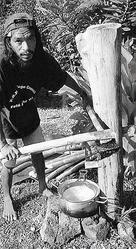

Extracting the juice from cane the traditional way. -Photos by Rosemary ParkinsonRum is one of the oldest and most varied of distilled beverages. It is made from sugar cane by-products, such as molasses and cane juice by process of fermentation and distillation. The distillate, a clear liquid, is then usually aged in oak and other casks.
Though it is produced in places such as Australia, India Reunion Island, and elsewhere around the world, the majority of rum production occurs in and around the Caribbean and along the Demerara River in South America. Appleton Estate is the oldest and largest sugar estate and distillery in Jamaica, also the birthplace of Appleton Estate Rums. Appleton Estate Rums have a unique style and are produced only in Jamaica.
There are several by-products that emerge from the process rum that is loved by many, such as molasses, bagasse, dunder, and ethanol.
Molasses or treacle
Molasses is a thick syrup that is made when making sugar from sugar cane. The quality of molasses depends on the maturity of the cane, the amount of sugar extracted, and the method of extraction.
Sulphured molasses is made from young green sugar cane and is treated with sulphur dioxide fumes during the sugar extraction process. The sugar cane plant is harvested and stripped of its leaves. Its juice is then extracted from the canes, usually by crushing or mashing. The juice is boiled to a concentrate which promotes the crystallisation of the sugar. At this stage (the first boiling and removal of sugar crystal), it is known as first molasses, which has the highest sugar content because comparatively little sugar has been extracted from the juice. Second molasses is created from a second boiling and sugar extraction, and has a slight bitter tinge.
The third boiling of the sugar syrup produces blackstrap molasses. The majority of sucrose from the original juice has been crystallised but blackstrap molasses is still mostly sugar by calories. Unlike refined sugars, it contains significant amounts of vitamins and minerals. Balackstrap molasses is a source of calcium, magnesium, potassium and iron. One tablespoon provides up to 20 per cent of the daily value of each of those nutrients. Blackstrap is used as a health supplement, as well as in the manufacture of cattle feed other industrial uses.
Bagasse
At Appleton Estate and distillery, all machines are operated by the use of bagasse as fuel that generates energy for the distillery, factory and machines. Bagasse is the biomass remaining after sugar cane stalks are crushed to extract their juice. A sugar factory produces nearly 30 per cent of bagasse out of its total crushing.
Bagasse is often used as a primary fuel source for sugar mills; when burned in quantity, it produces sufficient heat energy to supply all the needs of a typical sugar mill, with energy to spare. To this end, a secondary use for this waste product is in cogeneration, the use of a fuel source to provide both heat energy, used in the mill, and electricity, which is typically on-sold to the consumer electricity grid.
Dunder
At Appleton Estate, another by-product of cane is dunder, which is used as a fertilisation. Dunder is the material that is left after cane juice or diluted molasses has been fermented and distilled. Since the yeast has utilised sugar in the fermentation process, there is little sugar left in the dunder.
Ethanol
Ethanol produced from the sugar in cane is used as fuel in many countries. Ethanol can be mass-produced by fermentation of sugar or by hydration of ethylene from petroleum and other sources. Current interest in ethanol lies in production derived from crops (bio-ethanol), and thereis discussion about whether it is a sustainable energy resource that may offer environmental and long-term economic advantages over fossil fuels, like gasolene or diesel. It is readily obtained from the starch or sugar in a wide variety of crops. Ethanol fuel production depends on availability of land area, soil, water, and sunlight.
Ethanol may be produced from sugar cane or corn but in Brazil it is is produced from the latter, which is a more efficient source of fermentable carbohydrates as it is much easier to grow and process. Brazil has tropical climate that is required for the productive culture of sugar cane. Brazil is the world's largest sugar cane and ethanol producer. Also, the country's government sales taxes on gasolene, as well as subsidies for ethanol, have resulted in a profitable national ethanol industry. Nearly all fuelling stations in Brazil offer a choice of either gasolene type C or hydrated ethanol.
- Source: www.wikipedia.com
www. patentstorm.us
ww.freepatentsonline.com

